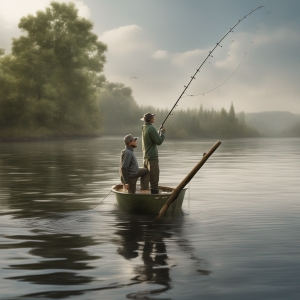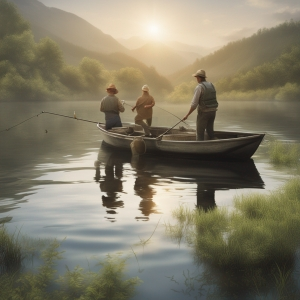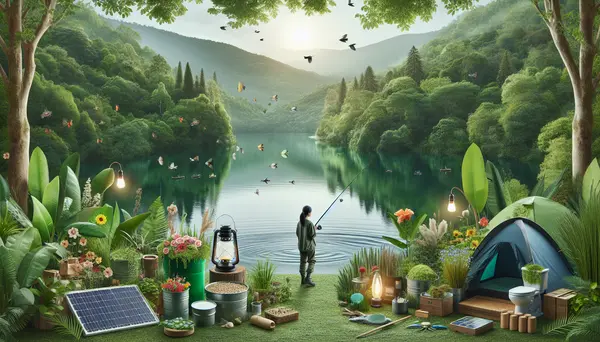Table of Contents:
Whether you're a seasoned angler or a beginner in the world of fishing, there's a pressing issue we all need to address - sustainable fishing practices. Alongside the joy and relaxation this hobby provides, we also carry a responsibility to protect our aquatic resources for future generations. To achieve a perfect balance between our need for recreation and the imperative of conservation, we need to revisit and rethink the way we fish. So, let's dive in.
Introduction to Sustainable Fishing Practices
The concept of sustainable fishing practices centers around a straightforward principle – taking care of our marine and freshwater resources so they can continue to thrive. It’s cognizant fishing, ensuring that our love for angling does not negatively impact the aquatic biodiversity. This includes employing fishing methods that cause minimal habitat damage and avoiding overfishing to ensure that fish populations can replenish.
Not only do these practices encourage a healthier and biodiverse ecosystem, but they also ensure that we can continue enjoying our fishing expeditions for years to come. Acknowledging that we are part of the ecosystem, not separate from it, is the first step towards adopting sustainable fishing practices. Following this path doesn't come with the sacrifice of fun or the thrill of fishing, it only adds another layer – that of purpose and responsibility. So, in line with the increasing global call for sustainability in all aspects of life, it's time we bring such consciousness to our fishing habits.
Understanding Conservation and Recreation
Both conservation and recreation can coexist harmoniously within the fishing world. Conservation is about safeguarding our natural resources, ensuring longevity of fish species, and preserving the delicate ecosystems they inhabit. Conversely, recreation refers to the enjoyment and relaxation we derive from fishing.
Now, you might ask, how do we balance these two seeming opposites? The answer lies in adopting sustainable fishing practices. By choosing the right catch methods, knowing species seasons, adhering to size and bag limits can we strike a healthy balance between the two. But remember, collaboration is key. As a community, we can make significant strides in maintaining this balance and educating each other on sustainable fishing practices.
All in all, the symbiosis of conservation and recreation in fishing reflects a bigger picture - our interaction with nature. Adopting sustainable fishing methods affirms our respect for nature and our aspiration to leave it unspoiled for the generations to come.
Comparison of Sustainable Fishing Practices
| Fishing Practices | Pros | Cons |
|---|---|---|
| Ecosystem-based Management | Considers the wider ecosystem impacts and sustainability | Requires extensive scientific knowledge and resources |
| Bycatch Reduction Devices | Helps prevent capture of non-target species | May not be 100% effective and can be costly to implement |
| Marine Protected Areas | Can help replenish fish stocks and protect habitats | Limits areas available for fishing, potentially affecting yields |
| Fishing Quotas | Regulates amount of fish capture to prevent overfishing | Can be difficult to enforce and monitor effectively |
The Importance of Sustainable Fishing

Sustainable fishing is crucial for maintaining the health of the world’s waters. The indiscriminate and excessive fishing practices of the past have led to troubling declines in many fish species populations. Sustainable fishing methods are a practical and effective solution to this looming crisis. By employing these practices, we not only ensure a thriving aquatic biodiversity but also the longevity of one of our favourite recreational activities - fishing.
Beyond conservation, sustainable fishing also has significant social and economic implications. Healthy fish populations support the livelihood of millions who depend on fishing, both for recreation and as a source of income. Therefore, the impetus for such an approach is not limited to environmental considerations alone.
Finally, inculcating a sense of respect for nature underscores the importance of sustainable fishing. When we as anglers adopt sustainable practices, we’re becoming part of a wider solution, leading to a positive ripple effect in our communities and paving the way for a future where fishing can be enjoyed responsibly and respectfully by all.
Methods of Sustainable Fishing
Sustainable fishing practices aren't just about awareness, they're about action. Equipping yourself with the right knowledge and tools can make a huge difference in your fishing footprint. Here are a few sustainable fishing methods you can incorporate into your next fishing trip:
The first method is the use of circle hooks. These hooks have a design that significantly reduces the possibility of deeply hooking a fish. They are especially crucial when you're practicing catch and release, as they lessen the harm to the fish and increase their chance of survival after release.
Secondly, respect size and bag limits. Regulations for size and bag limits are there for a reason. They aim to ensure the survival of juvenile fish and prevent overfishing. Breaking size and bag limits isn't just bad for the fish; it can also lead to hefty fines.
Thirdly, opt for barbless hooks. These hooks are easier to remove, causing less damage to the fish and making release quicker and less stressful for both you and the fish.
Finally, learn to identify fish species and their spawning seasons. Refraining from catching fish during their spawning time allows them to reproduce successfully, maintaining a healthy population. Knowledge of the local fish species in your area will also help you follow limits for specific species.
These methods aren't hard to adopt, but they do require a sense of responsibility and commitment. Adopting sustainable fishing practices enhances your personal connection with the environment and adds a new level of enjoyment to your fishing experience.
Benefits of Sustainable Fishing

Embracing sustainable fishing has numerous benefits that affect not just our current generations, but future ones as well. The biggest advantage that results from sustainable fishing is the preservation of aquatic life. These practices help maintain natural fish populations and allow them to recover, fostering a robust ecosystem teeming with biodiversity.
Beyond the environmental benefit, sustainable fishing practices also offer a socio-economic advantage. When fishing is done sustainably, millions of people who depend on the pastime for livelihood can continue to do so. The long-term economic benefit of protecting fish resources is substantial, contributing to a sustainable future for the fishing industry.
Finally, sustainable fishing practices enhance our fishing experience itself. By looking after the waters and preserving our fish numbers, we can enjoy the recreation of fishing for many generations to come. It brings us closer to the natural world, promotes a deeper appreciation for our environment and helps us enjoy a truly fulfilling experience.
Role of Recreational Anglers in Conservation
Recreational anglers play a pivotal role in conservation efforts. Often, they are at the frontlines, interacting directly with the species and ecosystems we aim to protect. What this means is that their choices in fishing methods, gear, and disposal of waste have a real, tangible impact on the environment.
Anglers can directly contribute to conservation by actively practicing catch and release, using more sustainable equipment like circle or barbless hooks, and taking care not to disrupt habitats. It also means obeying fishing regulations set in place to maintain species populations.
Furthermore, the sense of stewardship that comes naturally with being an angler can be channeled into advocacy and education. Anglers can raise awareness about the need for sustainable fishing within their communities, becoming ambassadors for these essential practices. They can herald changes in local fishing culture by setting an example and sharing their knowledge with other enthusiasts.
Finally, recreational anglers contribute significantly to conservation through licenses and permits fees. This source of income is often directly reinvested by authorities into research, hatchery programs, and other conservation initiatives. So, if you're an angler, every time you go out fishing, you're not just enjoying yourself; you're also playing a part in the preservation and stewardship of our amazing aqua-rich planet.
Conclusion: The Future of Fishing

The future of fishing hinges on our collective commitment to sustainable practices. We must recognise that as custodians of the earth, our actions today will define what happens tomorrow. By embracing sustainable fishing practices, we not only ensure the survival of numerous fish species, but also the continued enjoyment and growth of our angling pursuits.
Change must begin at the grassroots level, with each one of us. So, whether you are just planning on starting your first fishing trip or you are a seasoned angler, adopting sustainable fishing methods is the path forward.
More growth and interest in fishing should not directly equate to depleted fish populations or destroyed marine ecosystems. There are tons of options and innovations available to fish sustainably. We are in a position where we can exercise that, proving that human recreational pursuits and nature preservation do not need to be mutually exclusive. Together, we can work for a future where we continue to fish, but not at the expense of our planet.
Frequently Asked Questions about Sustainable Fishing
What is Sustainable Fishing?
Sustainable fishing is the practice of catching fish without jeopardizing the ecosystem or affecting the ability of future generations to enjoy and benefit from the same resource.
Why is Sustainable Fishing important?
Sustainable fishing is crucial for maintaining fish populations, preserving aquatic ecosystems, protecting species diversity, and ensuring food security for communities reliant on fishing.
How does recreational fishing fit into sustainable fishing?
Recreational fishing, when performed responsibly, can align with sustainable principles. This includes practicing catch and release, respecting seasons and size limits, and using equipment that minimizes harm to fish.
What are some sustainable fishing methods?
Sustainable fishing methods include pole-and-line fishing, handline fishing, using traps and pots, trolling and seine fishing - methods that minimize bycatch and habitat damage.
How can I support sustainable fishing?
You can support sustainable fishing by following regulations, learning about and using sustainable fishing practices, choosing seafood with sustainability certifications, and encouraging others to do the same.







